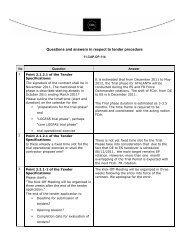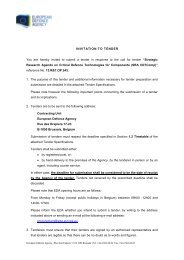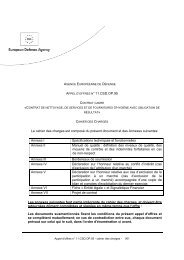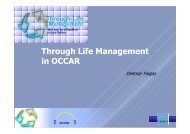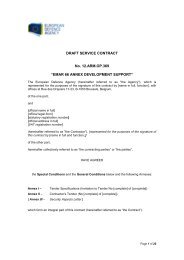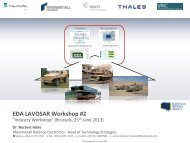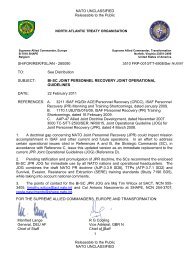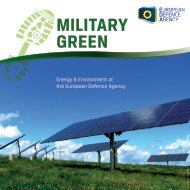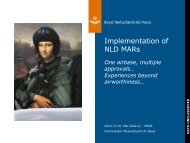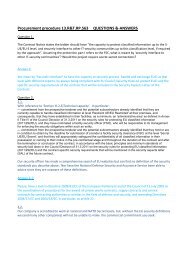capability development plan - European Defence Agency - Europa
capability development plan - European Defence Agency - Europa
capability development plan - European Defence Agency - Europa
You also want an ePaper? Increase the reach of your titles
YUMPU automatically turns print PDFs into web optimized ePapers that Google loves.
56<br />
THREATS AND CHALLENGES DERIVING FROM<br />
POTENTIAL ADVERSARIES<br />
a. Their utilisation of modern solutions is likely to make it possible for the adversaries to gain<br />
potentially devastating effects with limited effort.<br />
b. Adversaries will have access to equipment and systems that enables them to operate at night with<br />
night vision equipment and other nocturnal capabilities.<br />
c. Adversaries will be able to use robotics and unmanned platforms, CBRNE weapons and devices,<br />
ballistic missiles, thermo-baric weapons, rockets and mortars to threaten EU forces and local<br />
population.<br />
d. Adversaries will have increased access to electronic attack systems (EW, DEW) and thus, they will<br />
conduct electronic warfare against individual equipment, active protection systems (e.g. DIRCM) and<br />
C2 structure.<br />
e. Adversaries will be able to conduct deep operations. Adversaries may use advanced target<br />
acquisition systems and advanced stand-off capabilities and are likely to have access to greater<br />
quantities of precision munitions.<br />
44. Adversaries will try to choose an environment that minimises EU superiority of firepower and where<br />
forces lacking adequate force protection (i.e. lack of fire power; reduced mobility; light armour) can be<br />
confronted. They will avoid situations in which they compete with blue forces head-on.<br />
45. Adversaries may try to engage EU forces with attacks performed from underground.<br />
46. The current trends of using sophisticated IEDs, mines, autonomous systems, will continue. These<br />
will range in sophistication from command-detonated, bottom-dwelling sea mines to acoustically<br />
© EUFOR Tchad RCA<br />
detonated, pressure-activated wooden landmines. The use of semi-active laser–guided rounds, fired<br />
from single mortars or single guns or pairs of artillery systems will be used from concealed positions.<br />
47. Adversaries will have access to novel littoral and blue water capabilities. This will increase threat<br />
against all maritime assets.<br />
48. Adversaries will try to use speed boats / intelligent mines / cheap small arms / civilian assets and<br />
sophisticated land-based systems (UAVs, missiles, RPGs) and sea-based assets (UUVs, submarines,<br />
torpedoes) to disrupt maritime operations, inc. replenishment and sustainment activities.<br />
49. Adversaries will have access to modern smart mine technologies, which will create access<br />
challenges to EU forces and may increase the burden of mine clearance in order to provide safe<br />
passage within the littoral. New mines are likely to be used against LOCs and SPODs. Adversaries<br />
may conduct disinformation about mine threat levels and could use virtual and false mines.<br />
50. Adversaries’ ability to hide their activities among NGOs and local population will constrain EU<br />
forces’ ability to conduct air-to-ground missions (collateral damage).<br />
51. Adversaries may prioritise targeting MCM assets in order to deny freedom of movement.<br />
52. Adversaries may try to get access to temporary storage and disposal of weapons and ammo in<br />
order to cause collateral damage, which will reflect poorly on EU conduct. Conversely, they will have<br />
access to cutting edge and untraditional concealment methods, thereby making the detection of<br />
weapons and ammo more challenging.<br />
PRINCIPLE OF INTERACTION AND REACTION<br />
This considers the interplay between the conflict belligerents. Interaction is the activity that furthers the<br />
achievement of the objectives. Although necessary, perhaps even essential at times, security and<br />
protection, in itself, does not contribute to this aim. Exploiting opportunity to gain advantage is what all<br />
sides need to do - albeit their tactics may differ massively. Reactive activity also tries to contribute to<br />
the interaction by recapturing the initiative. Both are directly affected by the balance of knowledge and<br />
ignorance.<br />
Well informed forces dominate the tempo; they make use of all opportunities presented and avoid risk.<br />
Less informed forces find themselves reacting to the operational rhythm, trying to create opportunities<br />
based upon risky offensive actions. Again - a balance is required.<br />
FUTURE TRENDS FROM THE CAPABILITY DEVELOPMENT PLAN




